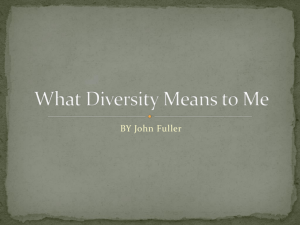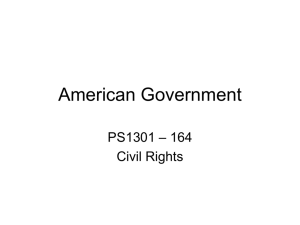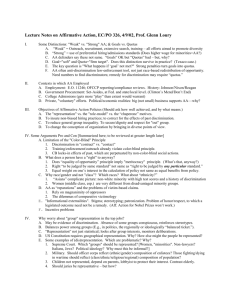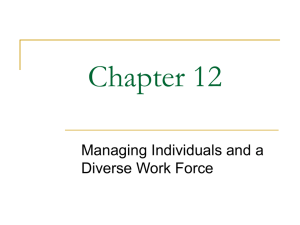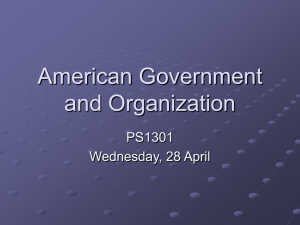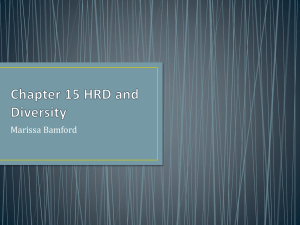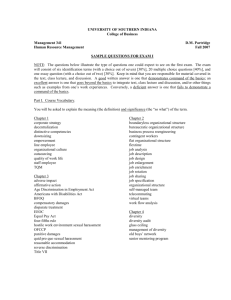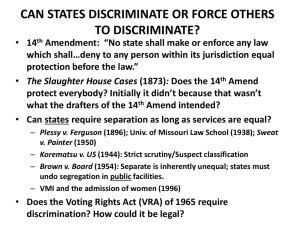Chapter 12
advertisement
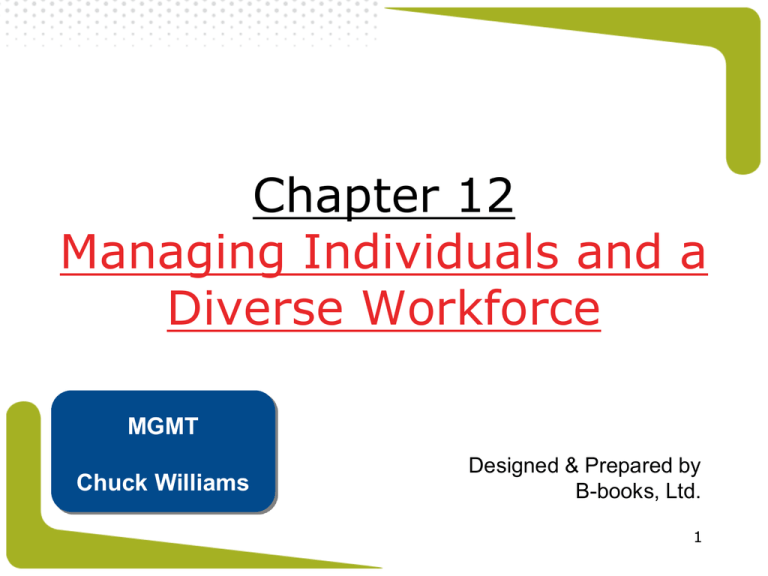
Chapter 12 Managing Individuals and a Diverse Workforce MGMT Chuck Williams Designed & Prepared by B-books, Ltd. 1 Predicted U.S. Population, by Race, 2005-2070 2 Diversity and Why It Matters After reading this section, you should be able to: 1. describe diversity and explain why it matters. 3 Diversity: Differences That Matter Diversity Is Not Affirmative Action How to Build a Business Case for Diversity 1 4 Diversity Is Not Affirmative Action Diversity May exist without a program Broad focus Not legally based Create a positive work environment Generally accepted Affirmative Action A purposeful, established program Narrow focus Legal requirement Compensate for past discrimination Controversial 1.1 5 Affirmative Action Programs The purpose of affirmative action programs is to… compensate for past discrimination prevent ongoing discrimination provide equal opportunities to all, regardless of race, color, religion, gender, or national origin 1.1 6 General Purpose of Diversity Programs To create a positive work environment where… no one is advantaged or disadvantaged. “we” is everyone. everyone can do his or her best work. differences are respected and not ignored. everyone feels comfortable. 1.1 7 Diversity Makes Good Business Sense Cost Savings Attracting and Retaining Talent Driving Business Growth 1.2 8 Diversity Makes Good Business Sense Cost Savings Reduces turnover Decreases absenteeism Avoids expensive lawsuits 1.2 9 Diversity Makes Good Business Sense Attracting and Retaining Talent Attracts better and more diverse job applicants Results in higher stock market performance Encourages workers to stay 1.2 10 Diversity Makes Good Business Sense Driving Business Growth Improves understanding of the marketplace Improves quality of problem solving 1.2 11 Diversity and Individual Differences After reading these sections, you should be able to: 2. understand the special challenges that the dimensions of surface-level diversity poses for managers. 3. explain how the dimensions of deep-level diversity affect individual behavior and interactions in the workplace. 12 Surface and Deep-Level Diversity Surface-Level Diversity Age Personality Physical Capabilities Attitudes Deep-Level Diversity Race/ Ethnicity Values/Beliefs Gender 13 Surface-Level Diversity Age Sex/Gender Race/Ethnicity Mental or Physical Disabilities 2 14 Age • • • • Treating people differently because of their age Performance does not decline with age Older employees show better judgment and are less likely to quit, show up late, or be absent Age discrimination is more pervasive than managers think 2.1 15 Gender • • • Treating people differently because of their sex or gender Glass ceiling – invisible barrier that keeps women and minorities from advancing to the top of the organization Can be diminished by: – mentoring – stopping unintentional behavior 2.2 16 Beyond the Book Female-Friendly Workplace • At Principal Financial Group , 66% of the employees and 35% of the board are women, and 50% of senior postions are held by women. Why? • Flexible schedules • Onsite gym • Early childhood education center • Opportunity for mentorship • Equal pay, equal access Source: J. Hempel, “In the Land of Women,” Fortune, . 17 Race / Ethnicity • • • • Treating people differently because of their race or ethnicity Employment disparities do exist Legislation has lessened the problem Reduce by: – eliminating unclear selection and promotion criteria – training managers who make hiring and promotion decisions 2.3 18 Mental or Physical Disabilities • • • Disability is a mental or physical impairment that substantially limits one or more major life activities. Disability discrimination means treating people differently because of their disabilities. Reduce by: – educating to address incorrect stereotypes – committing to reasonable workplace accommodations – recruiting qualified workers with disabilities 2.4 Web Link http://www.usdoj.gov/crt/ada/adahom1.htm 19 Reasonable Accommodations for Disabled Workers Physical changes Quieter workspace Training and other written materials TTYs for use with telephones, computer hardware, and software Time off for treatment 2.4 20 Deep-Level Diversity “Big Five” Dimensions of Personality Other Work-Related Aspects of Personality 3 21 Big Five Dimensions of Personality Extraversion Emotional Stability Agreeableness Conscientiousness Openness to Experience 3.1 22 How Can Diversity Be Managed? After reading these sections, you should be able to: 4. explain the basic principles and practices that can be used to manage diversity. 23 Managing Diversity Different Diversity Paradigms Diversity Principles Diversity Training and Practices 4 24 Diversity Paradigms 4.1 DIVERSITY PARADIGM FOCUS Discrimination and Fairness Equal opportunity Fair treatment Recruitment of minorities Strict compliance with laws Access and Legitimacy Acceptance and celebration of differences Learning And Effectiveness Integrating deep-level differences into organization 25 Organizational Plurality A work environment where: • all members are empowered to contribute in a way that maximizes the benefits to the organization, customers, themselves • the individuality of each member is respected by not segmenting or polarizing people based on their membership in a group 4.1 26 Benefits of the Learning and Effectiveness Diversity Paradigm Values common ground Makes a distinction between individual and group differences Less likely to encounter conflict, backlash, and divisiveness Focuses on bringing different talent and perspectives together 4.1 27 Diversity Principles 1. Carefully and faithfully follow and enforce all equal employment opportunity laws 2. Treat group differences as important, but not special 3. Tailor opportunities to individuals, not groups 4. Reexamine, but maintain, high standards 5. Solicit negative as well as positive feedback 6. Set high but realistic goals 4.2 Web Link http://www.eeoc.gov 28 Diversity Training and Practices Training Practices • Awareness Training Diversity Audits • Skills-Based Diversity Training Diversity Pairing Minority Experiences 4.3 29
